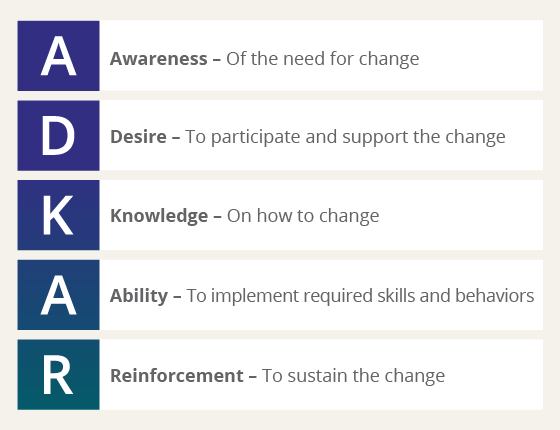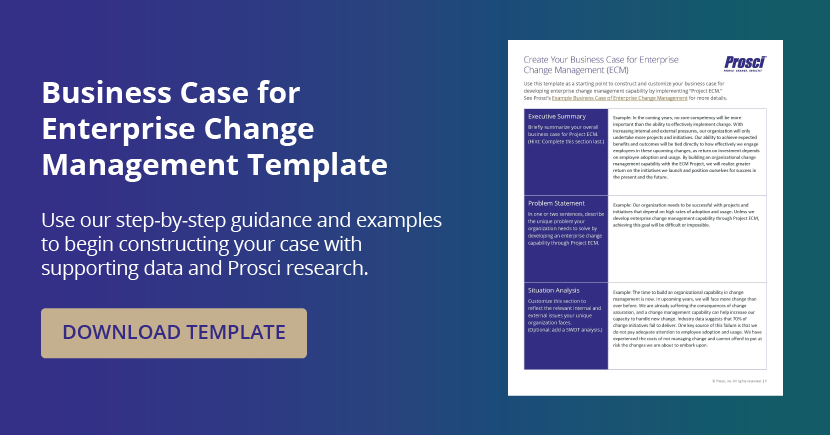Change Management Takes Change Management

4 Mins
Updated: February 4, 2025
Published: June 2, 2021

To say that change management takes change management may sound overly simplistic, especially to an experienced practitioner. Yet, obstacles and potential failures await change leaders who forget to apply change management to their own change management efforts.
In some cases, those change management efforts will get a head nod but no meaningful action. In other cases, your work may simply occur in the margin and have no impact on the project you're supporting. Your success at managing change on projects in your organization will depend on how you manage the people side of applying change management.
Change Management Mistakes
You probably know the saying, "The cobbler's children have no shoes." The point is, of course, that when we work too closely with something, we can neglect it in our own work.
Countless change management practitioners have fallen into this trap. It’s easier than you might think to dive headlong into a beautiful change management solution only to commit the errors you’re helping others avoid.
As a change management professional, you would chastise project teams for developing a new technology and simply dropping it on employees. You would help them understand the importance of making a compelling case for why the change is needed, the risks of not changing, and what is not working today. You would tell the team how important it is to have active and visible sponsors who demonstrate their commitment. You would help them provide the right training for the right roles at the right time in the project lifecycle. And you would clearly explain the risks of simply dropping a solution on employees.
When you reflect on your own change practices, you may see that you leverage change management as your solution and make every one of the mistakes above. You don't share why it’s important. You don't make a compelling case for why you need change management right now and the risks from not applying change management. You don't secure adequate sponsorship for change management. You send people to change management training without proper context. You fail to manage the individual and personal change your coworkers experience when you ask them to apply change management.
Change management practitioners need to apply what they know about change management to the task of getting others to adopt change management―and to avoid leaving the cobbler's children shoeless.
Changes needed for change success
Here are a few changes you need employees in your organization to make for change management to be successful on a project:
- Senior leaders must become great sponsors of change, going beyond signing a check and charter by being active and visible participants.
- Managers and supervisors must effectively coach their direct reports, going beyond announcing a change, including advocating for it and then supporting individuals through their change journeys.
- Project leaders must dedicate or bring in resources to manage the people side of change and integrate change management activities into the project lifecycle.
- Project team members must translate their solutions into the individual change that is required of specific employees who are impacted by the project or initiative.
- Project sponsors must request or require change management on the initiatives they fund.
Each of these needs is a specific change to how an individual does their work. It’s just like asking a front-line employee to adopt a new process, use a new tool, or follow new protocols. When you ask others in the organization to apply change management, you’re often asking them to change how they have done things in the past. Managing these personal transitions is fundamental to what "change management takes change management" means.
Applying the ADKAR Model to "applying change management"
The Prosci ADKAR Model describes the five building blocks of any successful change:

To start the change process, an individual first needs to understand why the change is needed. Following this, an individual must make the personal choice to participate. Once this decision is made, a person needs knowledge of how to change and the ability to implement the change. Finally, reinforcement keeps an individual from sliding back into the old ways of doing things. This model applies to changes at home, in the community, and at work. The Prosci ADKAR Model describes the five outcomes that, when combined, result in successful and lasting change.

Now, let's think about applying the same five building blocks to the change of "applying change management" in your organization:
- Awareness of the need for change management
- Desire to support change management
- Knowledge of how to apply change management
- Ability to demonstrate skills and behaviors required in change management
- Reinforcement to sustain the application of change management
ADKAR Model analysis and actions
When you "apply change management" as a change you must manage, you address change management in a new way. To get started, try the actions below.
Build Awareness and Desire
Help individuals connect change management to what they care about:
- Directly connect "managing the people side of change effectively" to better financial and strategic performance.
- Show that the success of organizational change is tied directly to the success of individual change.
- Provide data demonstrating that effective change management dramatically increases the probability of meeting objectives, finishing on time, and finishing on budget.
- Document the unnecessary costs and risks resulting from not managing the people side of change effectively.
- Declare to leaders that realizing the ROI they expect on the projects they’re funding requires effective change management, and that their role as sponsor is critical.
Build Knowledge and Ability
Help individuals understand their roles:
 Explain roles and responsibilities, and clearly articulate what they need to be doing.
Explain roles and responsibilities, and clearly articulate what they need to be doing.- Share the biggest mistakes sponsors make, highlighting what they should avoid doing as well as the risks.
- Leverage the latest Best Practices in Change Management research.
- Use examples of good and poor sponsorship.
Build Ability and Reinforcement
Help individuals fulfill their roles:
- Create the Sponsor Plan (one of the core change management plans in the Prosci 3-Phase Process)
- Do the legwork:
- Build presentations
- Craft key messages
- Draft email content
- Get them on calendars
- Provide coaching
- Give recognition
- Make it as easy as possible for them to be the face and voice of the change
Next, create a list with the elements above for each unique audience you ask to do change management, including:

- Project leaders
- Project managers
- Project team members
- Executives and senior leaders
- People managers
- Solution technicians who design the project changes
- Communications specialists
- Training specialists
- Learning and development specialists
Each group will make a change when they begin adopting and applying change management. How will you build Awareness, Desire, Knowledge, Ability and Reinforcement for "applying change management"?
Successfully Manage Change Management
Change practitioners must set the stage for success, which starts with treating change management like its own change. Identify the changes that you need to happen, including who needs to change, what they need to be doing, and how the new ways will differ. Deliver a compelling case for the value change management has to offer. Clearly articulate what you need to be done. Provide the necessary training, skills and tools to help the people you’re asking to make this change successful. And finally, acknowledge the work of individuals, celebrating the impacts they make on the project and organization when they apply change management.


